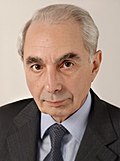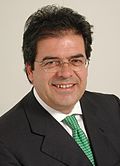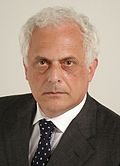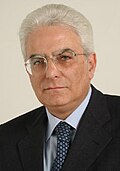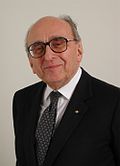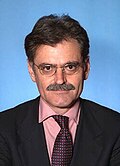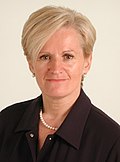Portrait Office Name Term Party Undersecretaries Prime Minister Giuliano Amato 26 April 2000 – 11 June 2001 Independent Enrico Luigi Micheli (PPI) Gianclaudio Bressa (PPI) [ a] Vannino Chiti (DS) [ b] Minister of Foreign Affairs Lamberto Dini 26 April 2000 – 11 June 2001 Italian Renewal Franco Danieli (Dem)Umberto Ranieri (DS)Rino Serri (DS)Ugo Intini (SDI) Minister of the Interior Enzo Bianco 26 April 2000 – 11 June 2001 The Democrats Aniello Di Nardo (Dem)Massimo Brutti (DS)Gian Franco Schietroma (SDI)Severino Lavagnini (PPI) Minister of Justice Piero Fassino 26 April 2000 – 11 June 2001 Democrats of the Left Franco Corleone (FdV)Marianna Li Calzi (RI)Rocco Maggi (Dem) Minister of Treasury, Budget and Economic Planning Vincenzo Visco 26 April 2000 – 11 June 2001 Democrats of the Left Dino Piero Giarda (Ind.)Gianfranco Morgando (PPI)Santino Pagano (UDEUR)Bruno Solaroli (DS) Minister of Finance Ottaviano Del Turco 26 April 2000 – 11 June 2001 Italian Democratic Socialists Natale D'Amico (RI)Alfiero Grandi (DS)Armando Veneto (PPI) Minister of Defense Sergio Mattarella 26 April 2000 – 11 June 2001 Italian People's Party Gianni Rivera (Dem)Marco Minniti (DS)Massimo Ostillio (UDEUR) Minister of Public Education Tullio De Mauro 26 April 2000 – 11 June 2001 Independent Giuseppe Gambale (Dem)Silvia Barbieri (DS)Giovanni Manzini (PPI)Carla Rocchi (FdV) Minister of Public Works Nerio Nesi 26 April 2000 – 11 June 2001 Party of Italian Communists Antonio Bargone (Ind.)Antonino Mangiacavallo (RI) Domenico Romano Carratelli (PPI) Salvatore Ladu (PPI) Minister of Agricultural and Forestry Policies Alfonso Pecoraro Scanio 26 April 2000 – 11 June 2001 Federation of the Greens Roberto Borroni (DS)Luigi Nocera (UDEUR) Minister of Transport and Navigation Pier Luigi Bersani 26 April 2000 – 11 June 2001 Democrats of the Left Giordano Angelini (DS)Luca Danese (UDEUR)Mario Occhipinti (Dem) Minister of Communications Salvatore Cardinale 26 April 2000 – 11 June 2001 Italian People's Party Michele Lauria (PPI)Vincenzo Maria Vita (DS) Minister of Industry, Commerce, Craftsmanship and Foreign Trade Enrico Letta 26 April 2000 – 11 June 2001 Italian People's Party Cesare De Piccoli (DS)Stefano Passigli (DS)Mauro Fabris (UDEUR) Minister of Health Umberto Veronesi 26 April 2000 – 11 June 2001 Independent Ombretta Fumagalli Carulli (RI)Grazia Labate (DS)Carla Rocchi (FdV) Minister of Cultural Heritage and Activities Giovanna Melandri 26 April 2000 – 11 June 2001 Democrats of the Left Giampaolo D'Andrea (PPI)Carlo Carli (DS) Minister of Labour and Social Security Cesare Salvi 26 April 2000 – 11 June 2001 Democrats of the Left Paolo Guerrini (PdCI)Raffaele Morese (Ind.)Ornella Piloni (DS) Minister of the Environment Willer Bordon 26 April 2000 – 11 June 2001 The Democrats Valerio Calzolaio (DS)Nicola Fusillo (PPI) Minister of University and Scientific and Technological Research Ortensio Zecchino 26 April 2000 – 2 February 2001 Italian People's Party Antonino Cuffaro (PdCI)Luciano Guerzoni (DS)Vincenzo Sica (Dem) Giuliano Amato (ad interim) 2 February 2001 – 11 June 2001 Independent Minister for Institutional Reforms (without portfolio) Antonio Maccanico 26 April 2000 – 11 June 2001 The Democrats Dario Franceschini (PPI) Minister for Equal Opportunities (without portfolio) Katia Bellillo 26 April 2000 – 11 June 2001 Party of Italian Communists Minister of Regional Affairs (without portfolio) Agazio Loiero 26 April 2000 – 11 June 2001 Union of Democrats for Europe Minister for Parliamentary Relations (without portfolio) Patrizia Toia 26 April 2000 – 11 June 2001 Italian People's Party Elena Montecchi (DS) Minister of Public Function (without portfolio) Franco Bassanini 26 April 2000 – 11 June 2001 Democrats of the Left Dario Franceschini (PPI) Gianclaudio Bressa (PPI) Raffaele Cananzi (PPI) Minister of Social Security (without portfolio) Livia Turco 26 April 2000 – 11 June 2001 Democrats of the Left Minister of Community Policies (without portfolio) Gianni Francesco Mattioli 26 April 2000 – 11 June 2001 Federation of the Greens 

